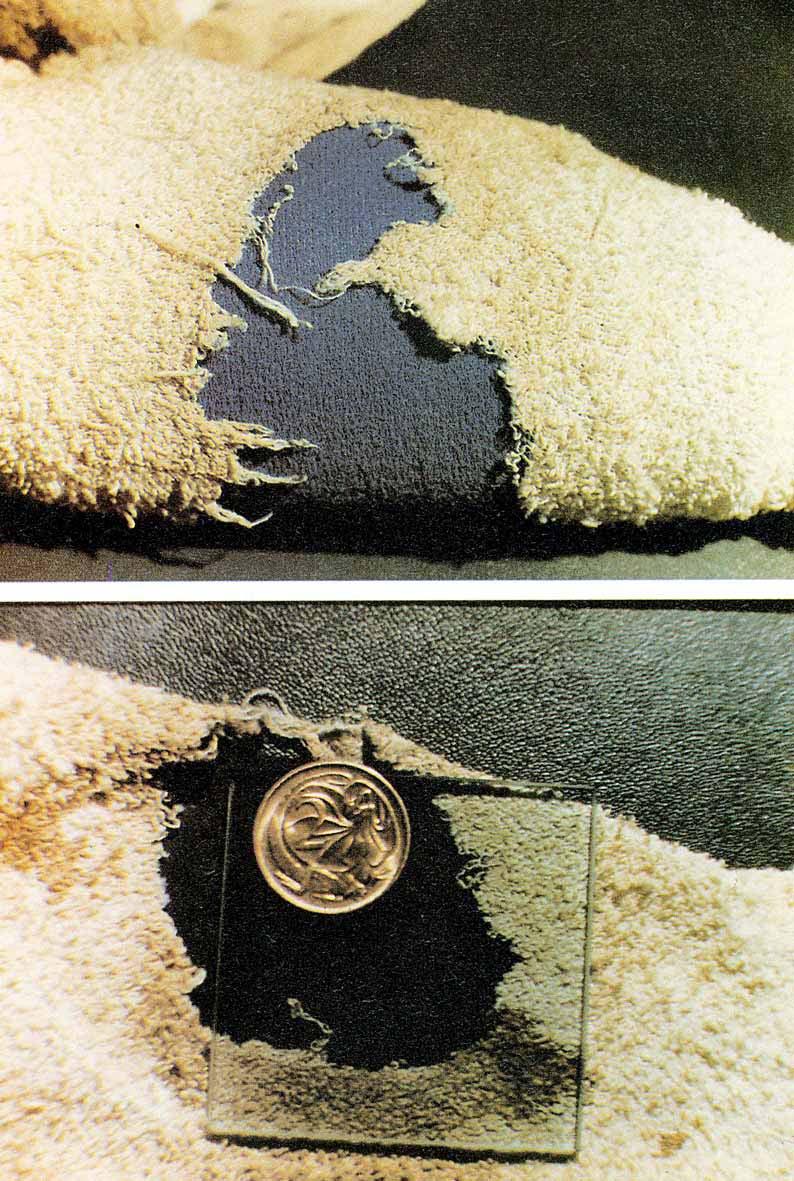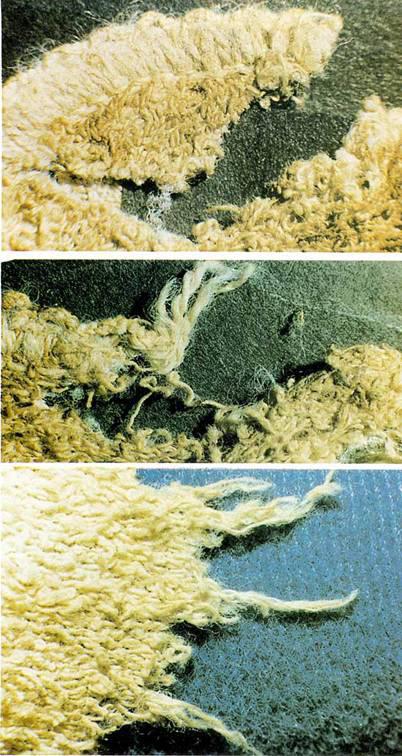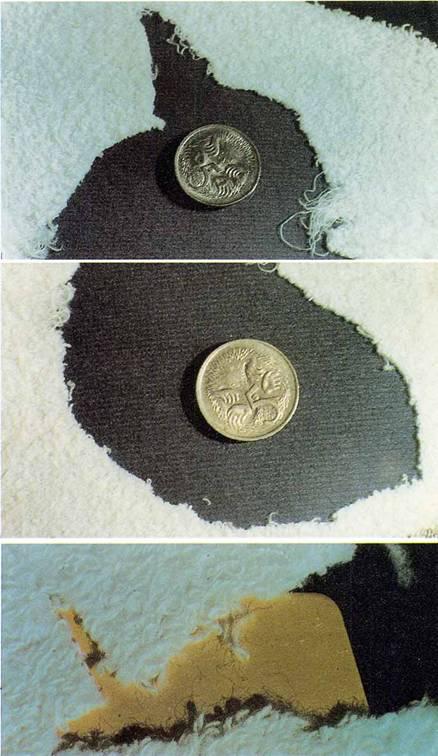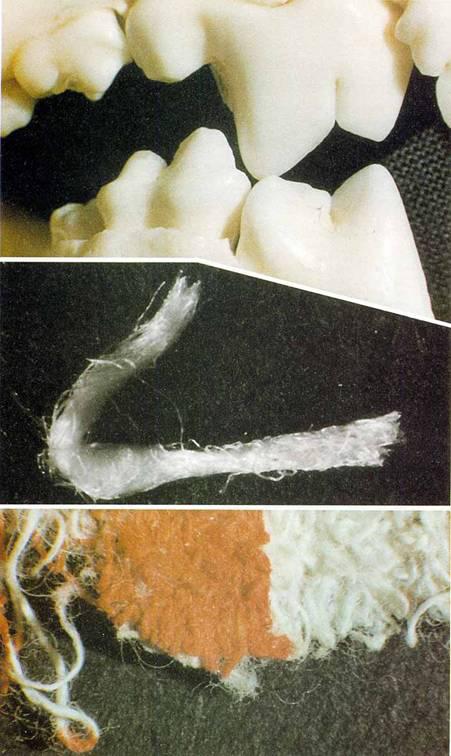Photograph 1. (top) A partial view of the damaged left sleeve in A
Chamberlain’s jumpsuit. At the top,
centre left and centre right, note the arcs of damage which are
comparable in size and shape to the
canine central incisor damage shown in Photograph 13.
Photograph 2. A partial view of the damaged sleeve of A
Chamberlain’s jumpsuit. The circumference of
the damage seen here is about 100mm. It is formed from about 10 small
cuts joined end to end.
These small cuts range in length from about 8mm up to 15mm. Compare
the size and appearance
of these cuts with known canine cuts, shown in Photograph 12.
Photograph 3. (top) The V cut in the collar of the Chamberlain
jumpsuit. The length and appearance
of these cuts led the Crown to argue that this damage could only have
been caused by scissors.
However further evidence now shows that such damage is entirely
consistent with canine action.
The stretched nylon thread, at the angle of the V is attached on both
sides of the cut.
This is inconsistent with the action of scissors.
Photograph 4. (centre) The cut in the collar of A Chamberlain’s
jumpsuit adjacent to the press stud.
The semi—detached tufts, stretched nylon threads and appearance of the
severed thread ends
are all typical of canine action.
Photograph 5. (bottom) An enlarged view of damage from A
Chamberlain’s jumpsuit, also shown in
Photograph 1, lower left. The appearance of this damage, which shows a
striking resemblance to
known canine damage, should be compared with the canine damage shown
in Photograph 15.
Photograph 6 (top) and Photograph 7. (centre) Scissor cuts in the
arm of a test jumpsuit.
These were produced in the courtroom by Sgt Cocks, to demonstrate how
the Crown
believed the damage in the Chamberlain jumpsuit had been caused.
Photograph 8. (bottom) The cut shown here in the collar of a test
jumpsuit, was produced in
the courtroom by Sgt Cocks to demonstrate how the Crown believed the
collar cut in the
Chamberlain jumpsuit had been made.
The Carnivores
describes
the action of the carnassial teeth as follows:
"The two constituent cusps [teeth] do not form straight lines but
are arranged so that each
blade has the shape of a wide open V. This increases efficiency by
preventing the meat
from slipping out forwards, and makes the action really more
comparable with that of
pruning shears than of ordinary scissors.’
Photograph 10. A cotton tuft, produced when the pile in Bonds
towelling fabric is cut with a
sharp instrument. At the trial the court was told that the presence of
these tufts constituted
the strongest possible evidence that A Chamberlain’s jumpsuit had been
cut with scissors.
It was not possible — the court was told — for dingo teeth to produce
tufts such as these.
The tufts shown in this photograph were produced by the action of
canine teeth.
Photograph 11. (bottom) The appearance of a group of threads seen
in a sample of canine
damaged fabric illustrates the cutting ability of canine teeth.
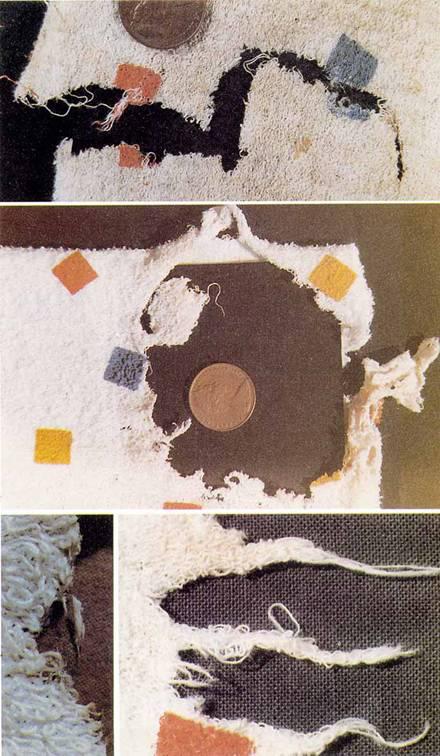
Photograph 12. (top) The damage seen in this photograph illustrates
a number of typical canine
damage features found in A Chamberlain’s jumpsuit. The zig—zag cut,
about 100mm long, is
formed from a series of smaller cuts, each about 12mm long, joined end
to end. The cut in the
sleeve of the Chamberlain jumpsuit (Photograph 2) is likewise formed
from a series of 12mm cuts.
Abrupt changes in the direction of cut, such as seen in the zig—zag
here are found in canine
damage patterns. Compare this with the abrupt change in direction of
the V cut in the
Chamberlain jumpsuit collar, shown in Photograph 3.
Photograph 13. (centre) The repeated arcs of damage in this fabric
sample (lower left) show the
damage resulting from the use of a dog’s central incisors in an action
reminiscent of a dog hunting fleas.
Photograph 14. (bottom left) The tuft shown in this photograph of
canine damaged fabric is still
attached to the main body of cloth by one or two fibres. Semi-detached
tufts such as these are
caused by small irregularities in the animal’s teeth, but do not
usually result from the action
of scissors. A comparable tuft in the Chamberlain jumpsuit can be seen
in Photograph 4.
Photograph 15. (bottom right) The tails of fabric shown here were
created when a dog secured the
fabric with a paw, grasped the other end of the cloth between her
central incisors
and raised her head (cf Photograph 5).
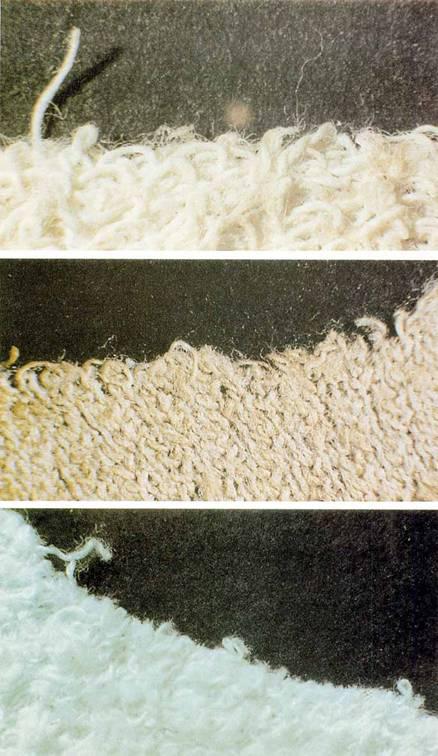
Photograph 16. (top) The appearance of a fabric edge cut by canine
teeth.
Photograph 17. (centre) The appearance of the cut fabric edge in A
Chamberlain’s jumpsuit.
Photograph 18. (bottom) The appearance of a scissor cut edge of
fabric.
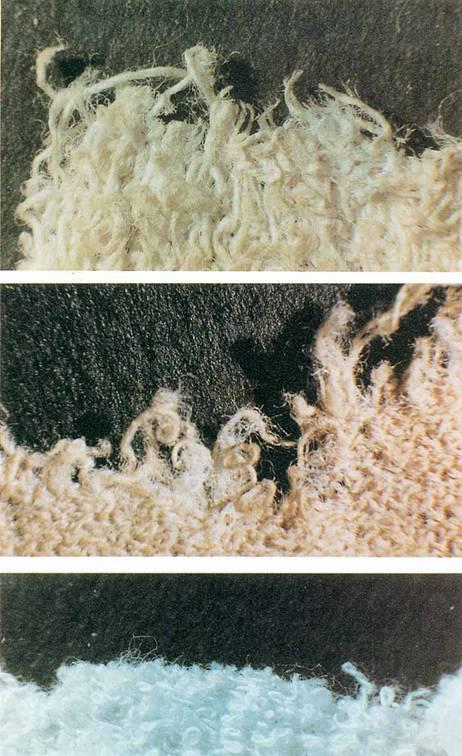
Photograph 19. A common appearance of fabric cut by canine
carnassial teeth.
Photograph 20. The appearance of the damage line in the sleeve of
the Chamberlain jumpsuit.
Photograph 21. The typical appearance of fabric cut by scissors.
This damage seen here is
from the jumpsuit cut by Sgt Cocks.
These photographs allow a 3 way comparison to be made between the
damage in the Chamberlain
jumpsuit and known canine damage. Such a comparison can be used to
determine whether a
difference exists between known scissor damage and the damage in the
Chamberlain jumpsuit
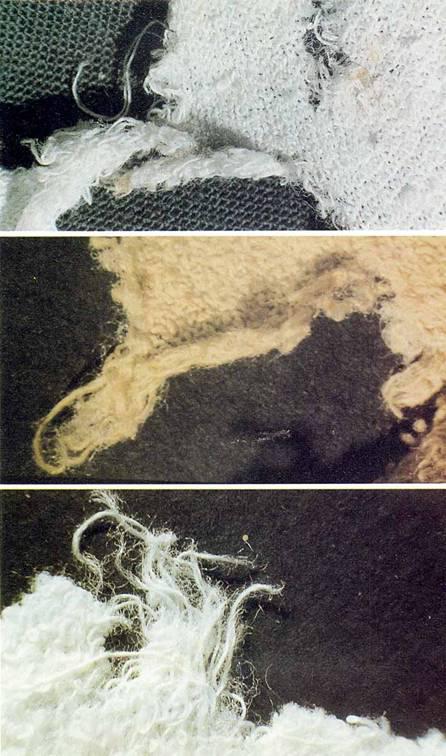
Photograph 22. (top) The damage seen here typically occurs when two
cuts made in the fabric
by a canine have not met and the animal has mauled the intervening
fabric. Note the curled
edge of the material, and the general matting of the threads where the
two cuts come together.
Photograph 23. (centre) The damage shown here is an enlargement of
the cloth tail seen in
the Chamberlain jumpsuit sleeve, Photograph 1, centre right. The
appearance of this damage
should be compared with that seen above.
Photograph 24. (bottom) This damage, from the Cocks jumpsuit
occurred when two scissor cuts
did not meet and the intervening fabric was torn apart. Compare this
with the damage seen
in both photographs above.
These photographs allow a 3 way comparison to be made between known
canine damage,
scissor damage and damage in A Chamberlain’s jumpsuit. They show that
over short
distances canine teeth can cut as well as scissors, and that features
other than the
presence of cuts are necessary to distinguish between scissor and
canine damage.
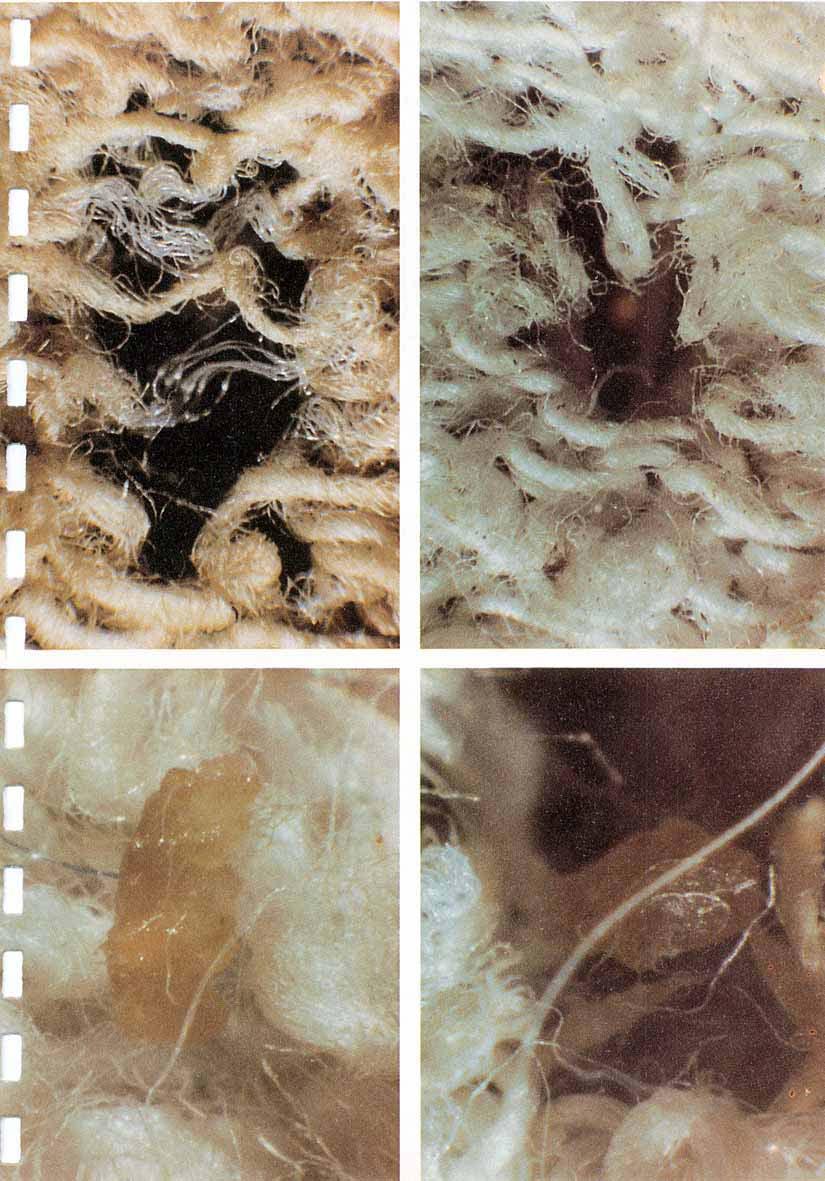
Photograph 25. (top left) A number of small isolated holes were
found in the centre back of A
Chamberlain’s jumpsuit. The court was told that if holes such as the
one shown here had
been caused by a dog they could not occur in isolation from other
holes or damage.
Photograph 26. (top right) One of a number of isolated holes found
in canine damaged fabric.
Photograph 27. (bottom right) A meat fragment embedded in the
fabric by the animal’s teeth.
Photograph 28. (bottom left) Small fragment of material seen in the
left arm of the Chamberlain jumpsuit.
These fragments should be compared with meat fragments embedded in
the fabric
by the animal’s teeth in Photograph 27.
By R D Bernett, K J Chapman, and L N Smith
Chamberlain Innocence Committee

